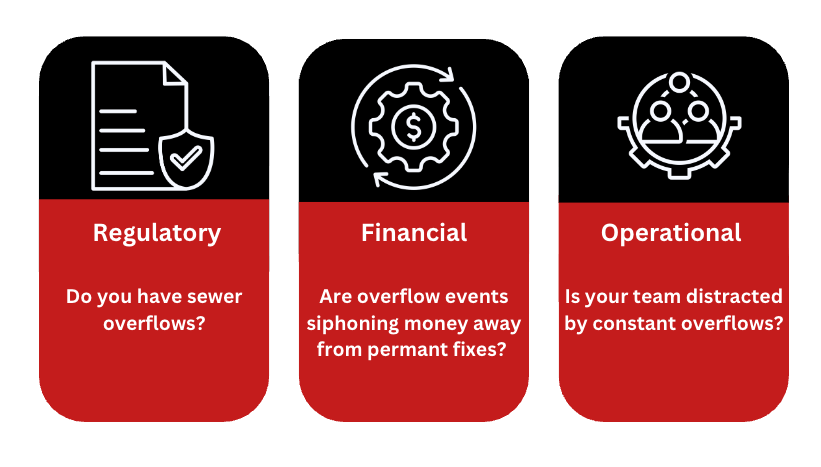- Infrasync Technology Services
- Posts
- Infrasync Newsletter #13 - $1 Billion in Wastewater Savings
Infrasync Newsletter #13 - $1 Billion in Wastewater Savings
How Three Utilities are Saving with Smart Sewer Innovations
Main Takeaways
- Case studies from three cities that saved over $1 billion combined.
- Essential strategies to address regulatory, financial, and operational challenges.
- Insights on how incorporating smart systems can significantly reduce costs and improve efficiency.
Why do some great utility ideas stall out vs why do some move forward?
It comes down to what NEEDS to be done vs what SHOULD be done. Many times, what NEEDS to be done gets confused with what SHOULD be done. This can confuse priorities in your team. Or even worse, your whole team is focused on something that SHOULD be done while ignoring something that NEEDS to be done.
Use a framework of 3 key areas

Regulatory – Are you required to do this by law? Or is there a risk that now doing something will end up violating the law? For sanitary sewers, there are many state regulations but at the national level the EPA is very strict with sanitary sewer overflows.
“EPA estimates there are at least 23,000 - 75,000 SSOs per year (not including sewage backups into buildings) in the U.S.”
Financial – Is this dragging you down financially and outside of budget limitations and causing you to siphon money from other needs? Sidestepping the larger impacts to the economy from sewer overflows. For every SSO spill there are significant costs to the utility for the direct response. I’ve seen costs anywhere from $5,000 to $15,000 per spill event to clean up, report, test, clean the sewers, and give the all clear. Additionally there are the huge capital project costs from expanding pipelines, pump stations, and treatment plants to deal with these increased flows.
Utility Name | Cost of Consent Decree | Cost per Person ($) |
City of Houston | $2,000,000,000 | $867 |
Louisville/Jefferson Co. MSD | $1,150,000,000 | $885 |
Miami-Dade County | $1,600,000,000 | $593 |
Operational – Is this impacting your day-to-day operations so your people cannot do a good job? Every single sewer overflow is a distraction from cleaning, pump maintenance, and other operator duties. Small overflows might be resolved within a few hours. Larger incidents can require several days of continuous work. This can mean anywhere from a few dozen to several hundred man hours spent on overflows instead of proactive maintenance.
Past the Why - Three utilities that took action on what NEEDED to be done and used technology.
At your utility, evaluate do you NEED to take action on sewer overflows? The answer is likely yes, but what exactly? Thankfully, we are not alone. Many utilities has been down this path before. They use a combination of sensors, software, and services to take control of their systems
Primary Issue | Primary Solution | Secondary Solution | Example |
Our sewer lines have too much I&I | Pipeline Replacement Program | Establish before, during, and after sewer metering to determine the effectiveness of each dollar spent | Hawthorne |
We have too much FOGs in the pipelines | Cleaning and Televising Program | Use sensors and software to identify the repeat offering pipelines so you can prioritize those for monthly cleanings | La Mesa |
We have capacity where we don’t need it | Place in control structures and pump stations | Use level sensors and coordinated controls to balance and move flows around during heavy rainfall | Louisville MSD |
Know someone who could benefit from this info? Forward this newsletter to them!

Hawthorne
Hawthorne, California, operates a small sewer system southeast of the Los Angeles Airport. It installed real-time remote sensors across about 2.5 percent of the sewer system (about 50 manholes). The sensors wirelessly connect to an analytics tool that allows the utility to see increasing water levels inside the system pipelines in real time. Since installing the system, the city has saved an estimated $2 million in fines and mitigation costs related to sewer overflows.

La Mesa
La Mesa, California, retains a rigorous preventive maintenance cleaning routine while cutting costs and improving productivity. Before the city turned to a smart solution, technicians cleaned the entire collection system each year along with nearly 100 “hot spots.” This gave them less time for other preventive tasks. To better pinpoint where cleaning was really needed, the city embarked on a pilot project using real-time, remote monitors to assess site conditions. The city cleaned 12 times during the pilot—an 80 percent reduction from its prior schedule. The real-time remote monitors saved more than $19,000 and enabled staff to focus on other maintenance needs to help prevent sanitary sewer overflows.

Louisville
Louisville and Jefferson County Metropolitan Sewer District in Kentucky implemented a system-wide smart sewer system. It installed real-time controls (RTCs) to optimize wastewater conveyance, storage, release, and transfer based on available system capacity. Optimization through RTCs has minimized overflows and relieved stress on the treatment system. As a result, the district has reduced combined sewer overflows by 1 billion gallons annually and saved about $117 million from the original long-term control plan estimate of $200 million (a 58 percent reduction in capital investment).
Is there someone else at your utility this could help? Forward this newsletter to them!
Make sense to connect?
Are you working to help your utility or technology company take the next step forward? If you want to talk through a challenge or share something interesting your team did please shoot me a note at [email protected] or schedule a 15 minute call here.
